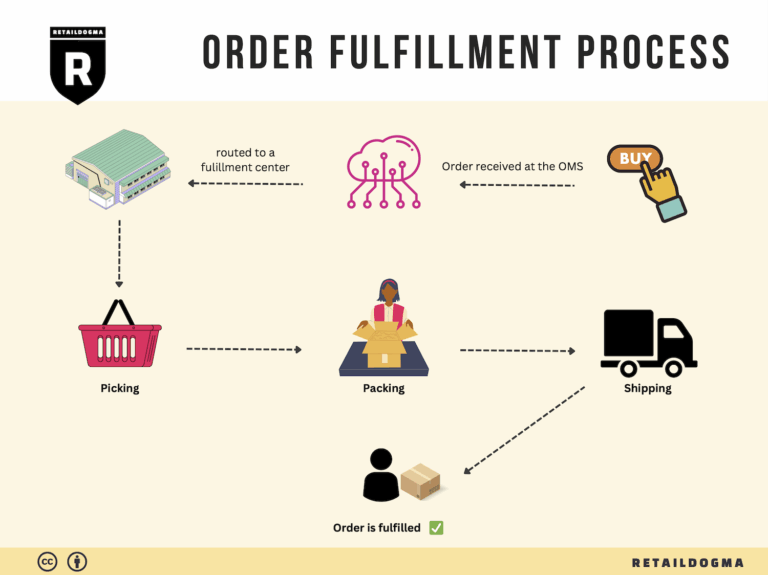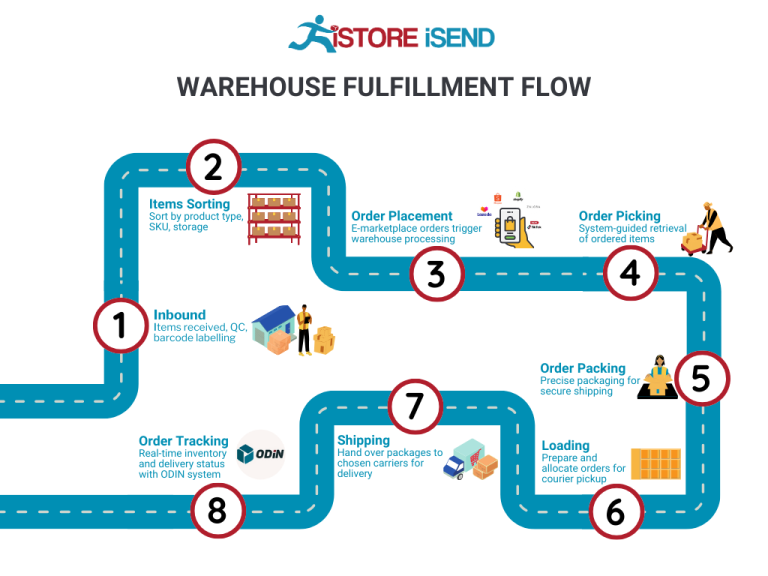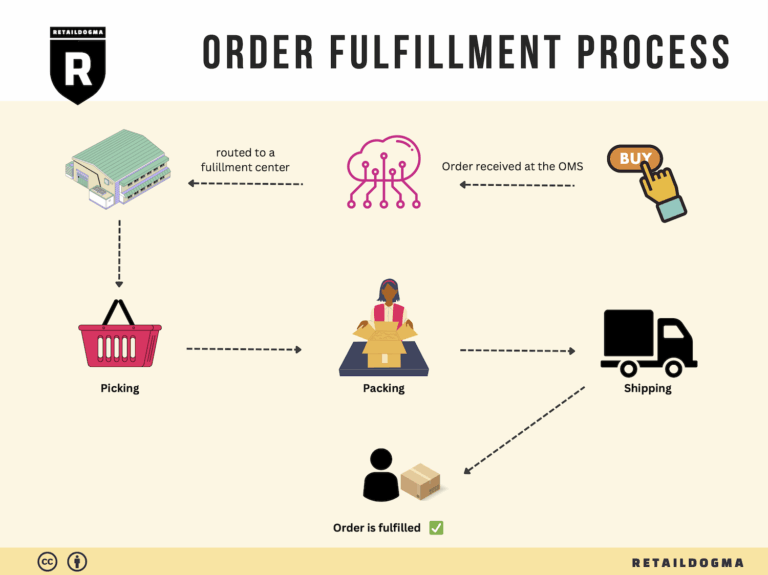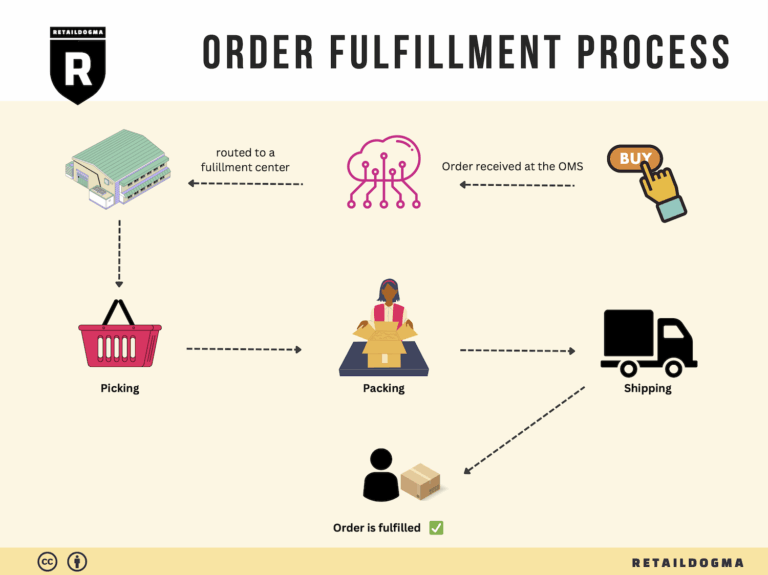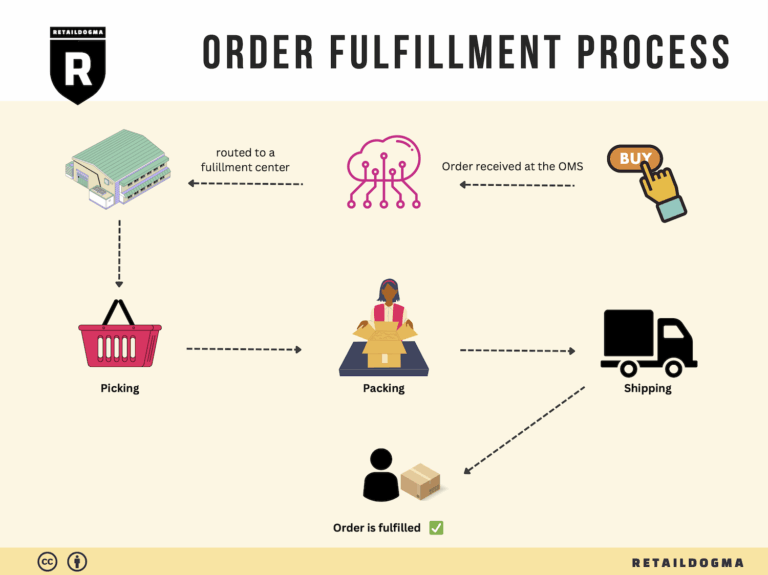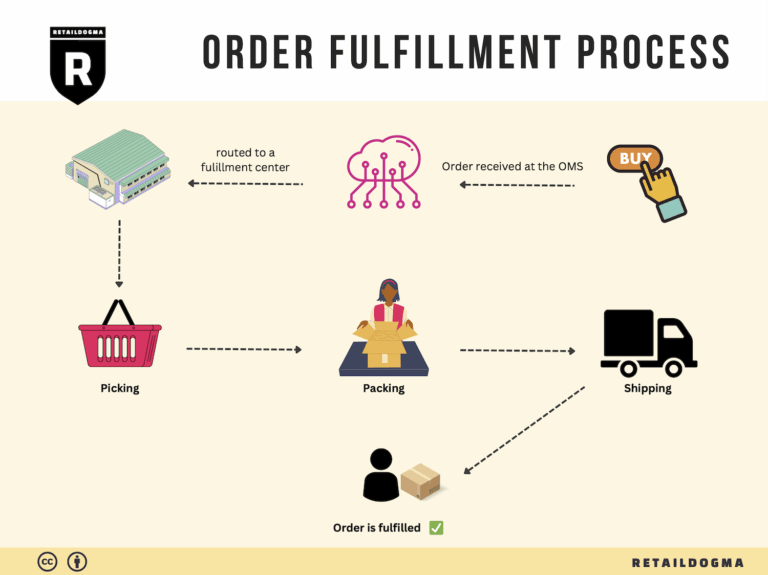How Order Fulfillment Works: A Step-by-Step Guide for Businesses
What is E-commerce Fulfillment? An Introduction for Growing Businesses
Understanding E-commerce Fulfillment: A Key to Scaling Your Business
As your e-commerce business begins to grow, the excitement of increased sales can quickly turn into a daunting challenge—managing the logistics of packing and shipping orders. Many entrepreneurs find themselves overwhelmed by the sheer volume of orders, struggling to keep up with customer expectations for timely delivery. This is where e-commerce fulfillment comes into play. At its core, fulfillment is the process of getting a product from your inventory to your customer’s doorstep, ensuring that each order is accurately packed, shipped, and delivered on time.
In today’s competitive landscape, efficient fulfillment is not just an operational necessity; it’s a critical component of customer satisfaction and brand loyalty. This guide aims to demystify the world of e-commerce fulfillment for growing businesses, providing you with the knowledge you need to make informed decisions.
What You’ll Learn
In this guide, we will explore the various fulfillment models available to e-commerce businesses, including third-party logistics (3PL) and Fulfillment by Amazon (FBA). Each model has its own advantages and drawbacks, and understanding these can help you choose the right solution for your business needs.
We will also outline the core services involved in fulfillment, such as inventory management, order processing, packing, shipping, and returns handling. Knowing what to expect from a fulfillment partner is essential to maintaining operational efficiency and ensuring a positive customer experience.
Choosing the right fulfillment partner can be one of the most significant decisions you make as a growing business. We will provide insights into the key factors to consider when evaluating potential partners, including their technology capabilities, customer service, scalability, and geographic reach.
Finally, we will delve into pricing structures associated with various fulfillment options. Understanding the costs involved will help you budget effectively and identify the most cost-efficient solutions without compromising on service quality.
Empowering Your Business Decisions
The goal of this guide is to empower you to make smart, strategic decisions about your logistics and fulfillment operations. With the right knowledge and tools, you can streamline your processes, enhance customer satisfaction, and ultimately drive growth for your e-commerce business. Let’s embark on this journey to optimize your fulfillment strategy and set your business up for success.
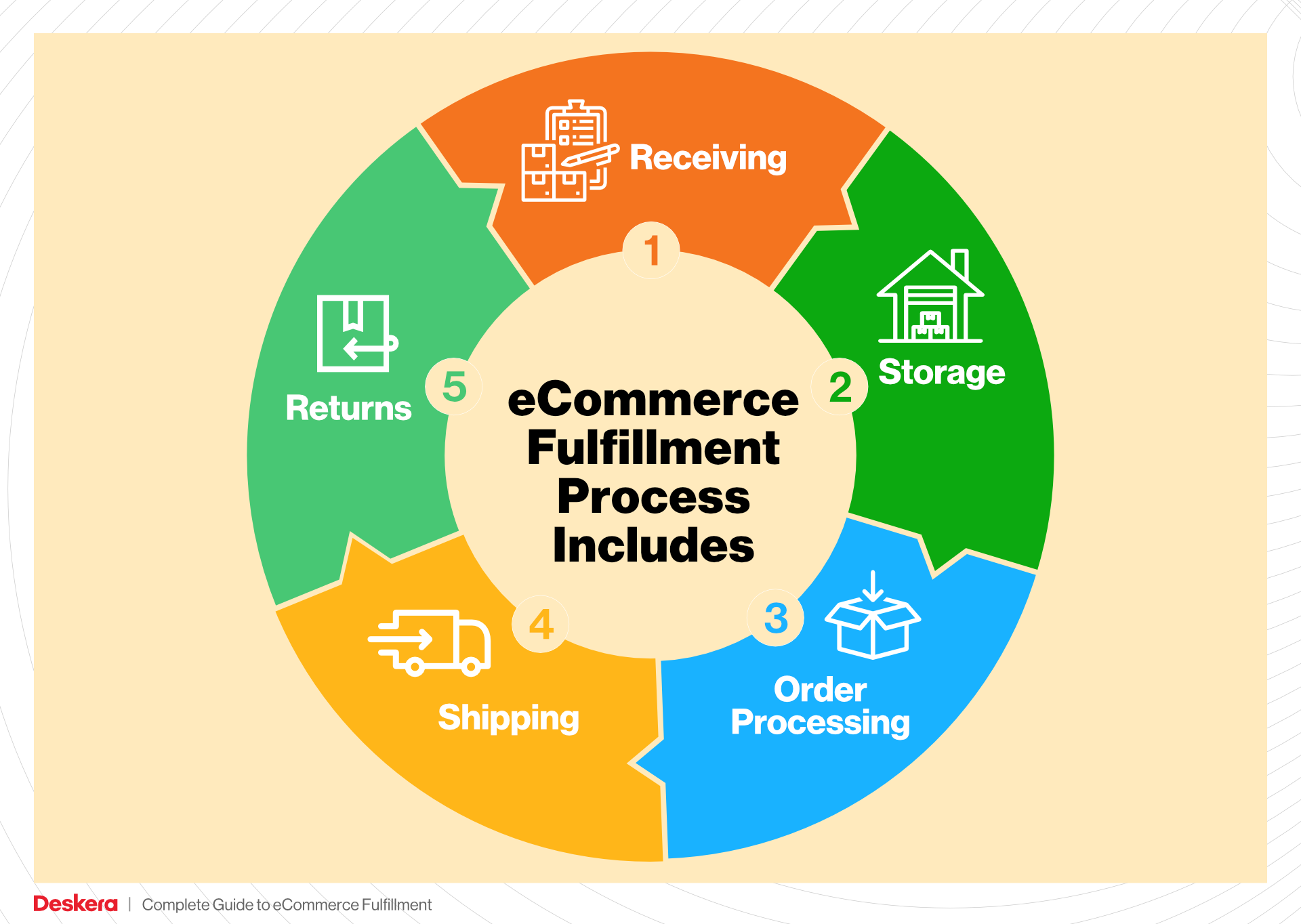
What You’ll Learn In This Guide
- What is E-commerce Fulfillment? An Introduction for Growing Businesses
- The Order Fulfillment Process: From ‘Buy’ Button to Customer’s Door
- Comparing Fulfillment Models: In-House vs. 3PL vs. Dropshipping
- A Deep Dive into Amazon FBA: Pros, Cons, and Who It’s For
- Core Services Offered by Fulfillment Centers
- How to Choose a Fulfillment Partner: A 6-Point Checklist
- Understanding Fulfillment Pricing: A Breakdown of Common Fees
- Frequently Asked Questions (FAQs) about Fulfillment
- Conclusion: Is Outsourcing Fulfillment the Right Move for Your Business?
- Important Disclaimer
The Order Fulfillment Process: From ‘Buy’ Button to Customer’s Door
1. Receiving Inventory
The order fulfillment process begins with receiving inventory at the fulfillment center. This step involves checking the incoming shipments against purchase orders to ensure accuracy. Products are inspected for damage and quality before they are accepted into the inventory.
Importance: Accurate receiving is critical as it sets the foundation for the entire fulfillment process. Errors at this stage can lead to inventory discrepancies, which can cause fulfillment delays and affect customer satisfaction.
Key Term: SKU (Stock Keeping Unit) – Each product is assigned a unique SKU, allowing for efficient tracking and management throughout the fulfillment process.
2. Warehouse Storage
Once the inventory is received and verified, products are stored in designated locations within the warehouse. This involves categorizing items based on their type, size, and sales velocity. High-demand products are often stored in easily accessible locations, while slower-moving items may be placed further away.
Importance: Proper storage organization maximizes space utilization and minimizes retrieval time. An efficient layout reduces the time workers spend searching for items, which is essential for maintaining fast order processing speeds.
Key Term: ABC Analysis – A method used to categorize inventory into three groups (A, B, and C) based on their importance and sales frequency, helping businesses prioritize storage and management efforts.
3. Order Picking
When a customer places an order, the next step is order picking, where items are retrieved from the warehouse. Workers use pick lists—documents that detail the items needed for each order—to guide them through the picking process. This can be done manually or with the assistance of automated systems, such as robots or conveyor belts.
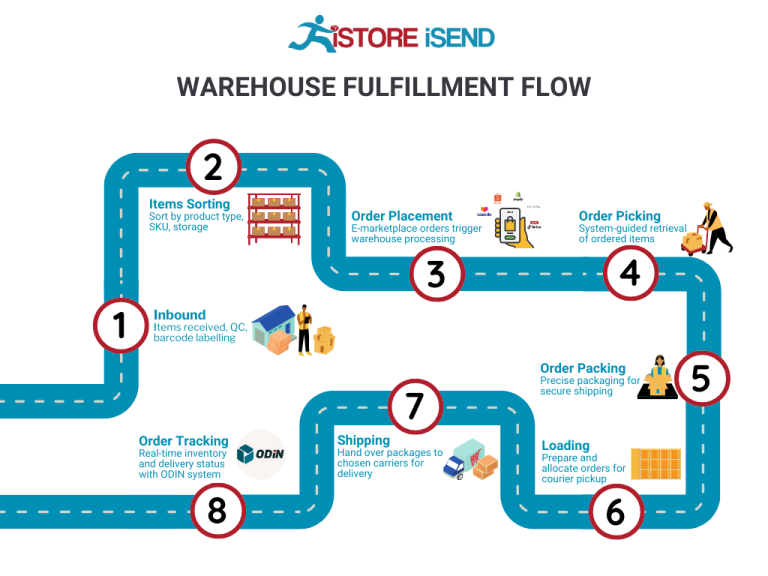
Importance: Efficient order picking is crucial for meeting customer expectations for speed and accuracy. The faster and more accurately items are picked, the quicker the order can be packed and shipped.
Key Term: Batch Picking – A strategy where multiple orders are picked simultaneously to improve efficiency, particularly in high-volume environments.
4. Order Packing
After items are picked, they are taken to the packing station, where they are carefully packed into boxes. This step includes weighing the package, adding necessary packing materials to prevent damage, and generating shipping labels.
Importance: Effective packing protects the products during transit and ensures they arrive at the customer’s location in perfect condition. Additionally, proper packing helps optimize shipping costs by minimizing dimensional weight.
Key Term: Packing Slip – A document included in the package that lists the items contained within, providing customers with a clear record of their order.
5. Shipping & Delivery
The final step in the order fulfillment process is shipping the packaged orders to customers. This involves selecting the most appropriate shipping method based on factors like cost, speed, and customer preference. Once the package is shipped, tracking information is provided to the customer.
Importance: Timely and accurate shipping is vital for customer satisfaction. The shipping process directly impacts the overall customer experience and can influence future purchasing decisions.
Key Term: Last Mile Delivery – The final step in the shipping process where the package is delivered from a transportation hub to the final destination, often considered the most critical and complex part of the delivery process.
Understanding these five steps—receiving inventory, warehouse storage, order picking, order packing, and shipping & delivery—provides a comprehensive view of the order fulfillment process. For e-commerce businesses looking to scale, optimizing each stage not only enhances operational efficiency but also significantly improves customer satisfaction, fostering loyalty and repeat business.
Comparing Fulfillment Models: In-House vs. 3PL vs. Dropshipping
Fulfillment Models Overview
When scaling an e-commerce business, choosing the right fulfillment model is crucial for operational efficiency, cost management, and customer satisfaction. Below is a comparison of three prevalent fulfillment models: In-House Fulfillment, Third-Party Logistics (3PL), and Dropshipping.
| Model | Who Handles Inventory | Best For (Business Stage) | Key Advantage | Key Disadvantage |
|---|---|---|---|---|
| In-House Fulfillment | The business itself | Established businesses with steady sales | Greater control over inventory and processes | High overhead costs and resource requirements |
| Third-Party Logistics (3PL) | A third-party provider | Growing businesses looking to scale | Scalability and access to specialized services | Less control over the fulfillment process |
| Dropshipping | Supplier or manufacturer | Startups and small businesses | Low upfront investment and risk | Lower profit margins and potential quality control issues |
In-House Fulfillment
In-house fulfillment involves managing the entire inventory and logistics process within your own business. This model is typically best suited for established businesses that have a consistent sales volume and can afford the overhead associated with warehousing, staffing, and technology.
Key Advantages: One of the primary benefits of in-house fulfillment is the level of control it provides. Businesses can directly manage inventory levels, order processing, and shipping. This control allows for greater flexibility in adapting to market demands, customizing packaging, and providing a personalized customer experience. Additionally, with in-house fulfillment, businesses can implement quality control measures more effectively, ensuring that products meet their standards before reaching the customer.
Key Disadvantages: However, in-house fulfillment comes with significant challenges. The overhead costs can be substantial, including warehousing, labor, and technology investments. This model requires a dedicated team to handle logistics, which can strain resources, especially for smaller businesses. Furthermore, as demand fluctuates, businesses may struggle with excess inventory or capacity constraints, making this model less adaptable to rapid growth.
Third-Party Logistics (3PL)
Third-party logistics (3PL) providers handle storage, order fulfillment, and shipping on behalf of businesses. This model is ideal for growing businesses looking to scale operations without the burden of managing logistics themselves.
Key Advantages: One of the most significant advantages of using a 3PL is scalability. Businesses can easily adjust their logistics needs based on sales volume without investing in additional infrastructure. 3PL providers often have established networks and expertise in logistics, allowing businesses to benefit from improved shipping rates and faster delivery times. Additionally, partnering with a 3PL can free up resources, allowing businesses to focus on core competencies like marketing and product development.
Key Disadvantages: On the downside, using a 3PL can lead to a loss of control over the fulfillment process. Businesses may find it challenging to manage customer service issues that arise from fulfillment mistakes made by the 3PL. Additionally, the fees associated with 3PL services can add up, impacting profit margins. Businesses must carefully vet potential 3PL partners to ensure they align with their operational standards and customer expectations.
Dropshipping
Dropshipping is a fulfillment model where retailers do not keep products in stock but instead transfer customer orders and shipment details to a supplier or manufacturer, who then ships the products directly to the customer. This model is particularly attractive to startups and small businesses with limited resources.
Key Advantages: The primary advantage of dropshipping is the minimal upfront investment required. Since businesses do not need to purchase inventory upfront, they can offer a wide range of products without the associated risks of holding stock. This model also allows entrepreneurs to test new products with low financial commitment and pivot quickly based on customer feedback.
Key Disadvantages: However, dropshipping also has its drawbacks. Profit margins can be lower compared to other fulfillment methods, as suppliers often charge higher prices for their services. Additionally, quality control can be an issue, as businesses rely on suppliers to deliver products that meet customer expectations. Shipping times can also be longer, particularly if suppliers are located overseas, which may lead to dissatisfaction among customers. Businesses using dropshipping must invest time in finding reliable suppliers and maintaining effective communication to mitigate these issues.
Conclusion
Selecting the right fulfillment model is a critical decision for e-commerce businesses aiming to scale. Each model has its unique advantages and disadvantages, and the choice ultimately depends on the specific needs, resources, and growth stage of the business. Understanding these models allows entrepreneurs and operations managers to make informed decisions that align with their business goals and customer expectations.
A Deep Dive into Amazon FBA: Pros, Cons, and Who It’s For
Understanding Fulfillment by Amazon (FBA)
Fulfillment by Amazon (FBA) is a service provided by Amazon that allows e-commerce sellers to store their products in Amazon’s fulfillment centers. Amazon takes care of storage, packaging, and shipping of the products directly to customers. Sellers simply need to send their inventory to Amazon, and the company handles the logistics, including customer service and returns. This service is particularly beneficial for small to medium-sized businesses looking to scale their operations without the overhead of managing their own fulfillment processes.
How FBA Works
-
Sign Up and Set Up: Sellers create an Amazon Seller account and enroll in the FBA program. This involves setting up product listings and determining which products will be fulfilled by Amazon.
-
Send Inventory: Sellers prepare their products for shipment to an Amazon fulfillment center. Amazon provides specific guidelines on packaging and labeling products to ensure they are processed correctly upon arrival.
-
Storage: Once the inventory arrives at the fulfillment center, Amazon stores it until an order is placed. Sellers are charged storage fees based on the volume of inventory stored.
-
Order Fulfillment: When a customer places an order, Amazon picks, packs, and ships the product on behalf of the seller. This includes managing the logistics and delivering the product directly to the customer.
-
Customer Service and Returns: Amazon handles all customer service inquiries and return processing related to FBA orders. This ensures a seamless experience for both the seller and the customer.
-
Payment and Fees: After an order is fulfilled, Amazon deposits the sales proceeds into the seller’s account, minus applicable fees for FBA services.
Pros of FBA
Prime Eligibility
One of the most significant advantages of using FBA is that it grants products Prime eligibility. This means that items fulfilled by Amazon can be offered with the Prime badge, making them more attractive to customers who are willing to pay for faster shipping options. Prime members are more likely to purchase products that qualify for Prime shipping, thus increasing sales potential.
Customer Trust
Amazon is a trusted name in e-commerce, and using FBA allows sellers to leverage this trust. Customers are often more willing to buy products from sellers who utilize FBA, as they are assured of Amazon’s customer service and return policies. This trust can lead to higher conversion rates and repeat business.
Multi-Channel Fulfillment
FBA isn’t limited to just Amazon sales. Sellers can use FBA to fulfill orders from other sales channels, including their own websites or third-party marketplaces. This multi-channel fulfillment capability allows sellers to streamline their logistics and provide a consistent customer experience across platforms.
Cons of FBA
High Fees
While FBA can simplify fulfillment, it comes at a cost. Amazon charges various fees, including fulfillment fees per unit sold and monthly storage fees based on the volume of inventory stored. For some sellers, particularly those with low-margin products, these fees can significantly cut into profits.
Strict Inventory Rules
Sellers must adhere to Amazon’s strict inventory management rules. This includes guidelines on how much inventory can be stored, how it should be packaged, and specific labeling requirements. Failure to comply can result in additional charges or penalties, making it essential for sellers to stay organized and informed.
Commingling Risks
FBA products may be commingled with inventory from other sellers, which can lead to issues if there are quality concerns. If a customer receives a defective product, it can reflect poorly on the seller, even if the seller’s own inventory is in good condition. This risk necessitates careful consideration for sellers of branded or unique products.
Who is FBA Best For?
Fulfillment by Amazon is best suited for sellers who want to scale their operations quickly and efficiently without the complexities of managing logistics on their own. Here are some types of sellers who can benefit most from FBA:
-
Small to Medium-Sized Businesses: Companies that do not have the resources to invest in their own fulfillment infrastructure can leverage FBA to access Amazon’s extensive logistics network.
-
Sellers with High Sales Volume: Businesses with a significant number of orders can benefit from the efficiency and speed of Amazon’s fulfillment processes.
-
Brand Owners: Sellers with established brands looking to increase their market reach and trust can benefit from the credibility and visibility that FBA provides.
-
E-commerce Entrepreneurs: New entrants in the e-commerce space who want to focus on marketing and sales rather than logistics can use FBA to streamline their operations.
In conclusion, while FBA presents a host of advantages, including Prime eligibility and customer trust, it is crucial for sellers to be aware of the associated fees and rules. Careful consideration of these factors will help determine if FBA aligns with their business goals and operational capabilities.
Core Services Offered by Fulfillment Centers
Inventory Management & Warehousing
Fulfillment centers like Amazon’s in Coppell play a crucial role in inventory management and warehousing. This service involves the systematic storage of products in a controlled environment, ensuring that businesses can maintain optimal stock levels without the burden of managing their own storage facilities.
Benefits:
-
Space Optimization: Utilizing a fulfillment center allows e-commerce businesses to free up physical space that can be repurposed for other operational needs. This is particularly beneficial for small to medium-sized businesses that may not have the resources to invest in large warehouse spaces.
-
Inventory Accuracy: Advanced inventory management systems used by fulfillment centers help maintain accurate stock counts, reducing the risk of overstocking or stockouts. This is crucial for maintaining customer satisfaction and trust.
-
Scalability: As your business grows, so do your inventory needs. Fulfillment centers provide the flexibility to scale your warehousing capabilities without the complexities of acquiring new property or managing additional staff.
-
Cost Efficiency: By outsourcing warehousing, businesses can reduce overhead costs associated with property leases, utilities, and maintenance. Fulfillment centers typically operate on a pay-as-you-go model, allowing for better cash flow management.
Pick and Pack Services
Pick and pack services are central to the order fulfillment process. This involves the selection of ordered products from the warehouse (picking) and preparing them for shipment (packing). Fulfillment centers use sophisticated technology and trained personnel to ensure that this process is both efficient and accurate.
Benefits:
-
Speed: Fulfillment centers are designed to process orders rapidly. With streamlined pick-and-pack operations, businesses can significantly reduce order lead times, enhancing customer satisfaction through faster delivery.
-
Accuracy: Errors in order fulfillment can lead to increased return rates and dissatisfied customers. Fulfillment centers employ rigorous quality control measures during the pick and pack process, ensuring that the right items are shipped to the correct customers.
-
Customization: Many fulfillment centers offer customizable packing options, including branded packaging, inserts, and gift wrapping. This allows e-commerce businesses to enhance their brand image and provide a personalized shopping experience.
-
Reduced Labor Costs: Outsourcing pick and pack services means businesses do not need to hire and train additional staff. This can lead to significant savings in labor costs, especially during peak seasons.
Kitting and Assembly
Kitting and assembly services involve the grouping of individual products into a single, ready-to-sell unit, or assembling products that require multiple components. This service is particularly valuable for businesses that offer products that are sold together or require assembly before shipping.
Benefits:
-
Streamlined Operations: By outsourcing kitting and assembly, e-commerce businesses can streamline their operations and focus on core competencies such as marketing and customer service. This can lead to increased productivity and business growth.
-
Enhanced Customer Experience: Providing customers with a ready-to-use product enhances their overall shopping experience. Kitting services ensure that customers receive complete products without needing to assemble them themselves.
-
Inventory Management: Kitting allows businesses to manage inventory more effectively by reducing the number of individual SKUs. This can simplify inventory tracking and reduce storage costs.
-
Cost Savings: By combining products into kits, businesses can often reduce shipping costs due to the lower volume of packages sent. Additionally, kitting can lead to bulk purchasing discounts from suppliers.
Returns Management (Reverse Logistics)
Returns management, or reverse logistics, is the process of handling returned goods from customers. This service is essential for e-commerce businesses, as it can significantly impact customer satisfaction and loyalty.
Benefits:
-
Efficiency: Fulfillment centers are equipped to handle returns efficiently, ensuring that products are processed, inspected, and restocked quickly. This minimizes the impact of returns on inventory levels and cash flow.
-
Customer Satisfaction: A hassle-free return process enhances the customer experience. Fulfillment centers often provide clear return policies and procedures, making it easier for customers to return products, which can lead to increased repeat business.
-
Data Insights: Fulfillment centers can provide valuable data on return reasons, helping businesses identify trends and areas for improvement in their products or services. This feedback loop can be instrumental in reducing future return rates.
-
Cost Management: Efficient returns management can help mitigate costs associated with returns, such as shipping fees and restocking expenses. Fulfillment centers often have established processes for handling returns, allowing businesses to manage these costs more effectively.
In conclusion, partnering with a fulfillment center like those in Coppell can provide e-commerce businesses with comprehensive services that enhance operational efficiency, reduce costs, and improve customer satisfaction. By leveraging these core services, businesses can focus on scaling their operations while leaving logistics and fulfillment in the hands of experts.
How to Choose a Fulfillment Partner: A 6-Point Checklist
Location & Warehouse Network
Importance: The geographical location of your fulfillment partner’s warehouses plays a crucial role in your shipping costs and delivery times. Proximity to your customer base can significantly reduce transit times and increase customer satisfaction.
Questions to Ask:
– How many fulfillment centers do you operate, and where are they located?
– What is your strategy for shipping to various regions, and how does your location enhance that strategy?
– Do you have the ability to support international shipping if my business expands globally?
– Can you provide insights into your shipping rates based on different locations?
Technology & Integrations
Importance: A robust technology platform can streamline your operations and improve order accuracy. Look for partners that offer advanced systems for inventory management, order tracking, and reporting, as well as seamless integration with your e-commerce platform.
Questions to Ask:
– What technology do you use for inventory management and order processing?
– How do your systems integrate with popular e-commerce platforms like Shopify, WooCommerce, or Amazon?
– Can you provide real-time inventory updates and tracking information?
– How do you handle system outages or technical issues?
Specializations (e.g., Cold Storage, Oversized Items)
Importance: Depending on your product range, you may require specialized services. Whether it’s handling perishable goods, oversized items, or hazardous materials, ensure your fulfillment partner can meet these specific needs.
Questions to Ask:
– What types of products do you specialize in handling?
– Do you have the capability for temperature-controlled storage or special handling requirements?
– How do you ensure compliance with regulations for specialized products?
– Can you provide examples of how you’ve successfully managed similar products for other clients?
Scalability & Capacity
Importance: As your business grows, your fulfillment needs will evolve. A partner that can scale with you can save you the hassle of switching providers and the associated costs. Assess their capacity to handle fluctuating order volumes and peak seasons.
Questions to Ask:
– What is your current capacity, and how do you manage peak seasons?
– How quickly can you scale operations if my order volume increases significantly?
– What systems do you have in place to manage order surges or unexpected spikes in demand?
– Can you provide references from clients who have scaled their operations with you?
Pricing and Contracts
Importance: Understanding the pricing structure is vital to ensure that the partnership remains profitable. Look for transparency in pricing and be wary of hidden fees that could eat into your margins.
Questions to Ask:
– What is your pricing model (e.g., per order, per item, monthly fees)?
– Are there any additional fees for services such as returns processing, storage, or special handling?
– Can you provide a detailed breakdown of all costs associated with your services?
– What are the terms of the contract, and is there flexibility for renegotiation as my business evolves?
Customer Support & Reviews
Importance: Reliable customer support can make or break your fulfillment experience. Look for a partner with a strong reputation for customer service, as this will impact your operations and ultimately your customer satisfaction.
Questions to Ask:
– What customer support options do you provide (e.g., phone, email, live chat)?
– How quickly can I expect a response to inquiries or issues?
– Can you share case studies or testimonials from current clients about your customer service?
– What measures do you take to handle customer complaints and ensure continuous improvement?
Conclusion
Choosing the right fulfillment partner is crucial for the success of your e-commerce business. By using this checklist, you can ensure that you’re considering all the important aspects of a potential partnership. Take the time to thoroughly vet each partner based on these criteria, and don’t hesitate to ask for references or case studies to support their claims. A well-chosen fulfillment partner can not only streamline your operations but also enhance your customer satisfaction, ultimately leading to increased sales and growth.
Understanding Fulfillment Pricing: A Breakdown of Common Fees
Initial Setup Fees
When starting with a fulfillment center, businesses often encounter initial setup fees. These fees typically cover the cost of onboarding your products into the fulfillment system. This may include creating product listings, integrating your e-commerce platform with the fulfillment provider’s systems, and establishing inventory management protocols.
The calculation of initial setup fees can vary widely based on the complexity of your product catalog and the level of customization required for your integration. Some fulfillment centers may charge a flat fee, while others may assess fees based on the number of SKUs (Stock Keeping Units) you plan to store and fulfill through their services. It’s crucial to clarify the scope of these fees during the negotiation phase to avoid unexpected costs.
Receiving Fees
Receiving fees are charged when your inventory arrives at the fulfillment center. This fee is generally based on the volume or quantity of the products being received and processed. For instance, if you are sending a large shipment of goods, the fulfillment center may charge a fee per pallet or per item, depending on their pricing model.
The calculation of receiving fees often involves several factors, including:
- Volume of Goods: More items or larger shipments may lead to higher fees.
- Condition of Goods: If products require special handling or inspection, additional charges may apply.
- Speed of Processing: Expedited receiving services can also incur extra costs.
Understanding the specifics of receiving fees can help you plan your inventory shipments more effectively.
Storage Fees (per pallet/bin)
Storage fees are a recurring expense that businesses incur while their products are held at the fulfillment center. These fees are typically calculated on a per-pallet or per-bin basis and can vary depending on the size and nature of the products.
Many fulfillment centers charge monthly storage fees, which can be tiered based on the volume of goods stored. For example, the first few pallets might incur a lower rate, while additional pallets are charged at a higher rate.
It’s important to note that storage fees may also fluctuate during peak seasons, such as the holiday shopping period, when demand for storage space surges. To minimize storage costs, consider implementing effective inventory management strategies, such as just-in-time inventory practices or regular inventory audits to remove slow-moving products.
Pick & Pack Fees (per item/order)
Pick and pack fees are charged for the labor involved in retrieving items from storage and preparing them for shipment. This fee is typically calculated on a per-item or per-order basis, meaning that the more items you sell, the higher your pick and pack fees will be.
The calculation of pick and pack fees generally includes:
- Number of Items: Each item picked adds to the overall fee.
- Complexity of Orders: Orders requiring special packaging or additional handling may incur higher fees.
- Order Frequency: Some fulfillment centers may offer discounted rates for businesses with high order volumes.
To reduce pick and pack fees, consider streamlining your product offerings or negotiating bulk order discounts with your fulfillment provider.
Shipping Fees
Shipping fees are one of the most significant costs associated with fulfillment services. These fees are typically based on the shipping method selected (e.g., standard, expedited, overnight), the destination of the package, and the weight or dimensions of the package.
Shipping fees can be influenced by several factors, including:
- Carrier Rates: Different carriers have varying rates; partnerships with specific carriers may yield discounts.
- Order Size and Weight: Heavier or larger packages generally cost more to ship.
- Distance: Shipping costs can increase significantly for long-distance deliveries.
To better manage shipping fees, consider using a fulfillment center that offers discounted shipping rates due to high volume shipping agreements with carriers.
Tips for Getting an Accurate Quote
- Be Transparent: Provide complete and accurate information about your inventory, including dimensions, weight, and any special handling needs.
- Request Detailed Quotes: Ask for itemized quotes that break down each fee component, allowing you to understand the cost structure clearly.
- Compare Multiple Providers: Don’t settle on the first quote; compare rates and services from multiple fulfillment centers to ensure competitive pricing.
- Understand Terms: Clarify any additional fees that may apply, such as seasonal surcharges or long-term storage fees, to avoid surprises.
- Negotiate: Many fulfillment centers are open to negotiation, especially if you anticipate high order volumes.
By following these guidelines, you can ensure you have a comprehensive understanding of fulfillment pricing and make informed decisions to optimize your logistics and operations.
Frequently Asked Questions (FAQs) about Fulfillment
1. What is an Amazon Fulfillment Center in Coppell?
An Amazon Fulfillment Center in Coppell is a large-scale distribution facility that specializes in the storage, packaging, and shipping of a wide variety of products sold on Amazon. These centers are integral to Amazon’s logistics network, ensuring that customer orders are processed efficiently and delivered promptly.
2. How does Amazon ensure fast delivery from its Coppell fulfillment centers?
Amazon utilizes advanced technology, including automated systems and robotics, to streamline the sorting and packaging process. The Coppell fulfillment centers operate 24/7 (except on Christmas and New Year’s Day), allowing them to manage high volumes of orders and maintain rapid delivery times, often within one to two days.
3. What’s the difference between a warehouse and a fulfillment center?
A warehouse primarily serves as a storage space for goods, focusing on inventory management and long-term storage. In contrast, a fulfillment center is designed specifically for order processing, packing, and shipping products directly to customers. Fulfillment centers emphasize speed and efficiency in getting products out the door.
4. What is a 3PL (Third-Party Logistics)?
A 3PL is a service provider that offers logistics and supply chain management services to businesses. This can include warehousing, fulfillment, transportation, and distribution. E-commerce businesses often partner with 3PLs to enhance their logistics capabilities without the need to manage their own fulfillment centers.
5. How much do fulfillment services cost?
Fulfillment service costs can vary widely based on several factors, including the volume of orders, storage space required, and the specific services needed (e.g., packaging, shipping, returns management). Typically, businesses can expect to pay a combination of storage fees, pick-and-pack fees, and shipping costs. It’s essential to request quotes from multiple providers to compare pricing.
6. What types of products can be stored and shipped from the Coppell fulfillment centers?
The Coppell fulfillment centers handle a wide range of products, including electronics, household goods, clothing, and more. However, specific facilities may specialize in certain categories, so it’s important to verify whether your products align with the center’s capabilities.
7. Can small businesses use Amazon Fulfillment Centers?
Yes, small businesses can utilize Amazon Fulfillment Centers through the Fulfillment by Amazon (FBA) program. This program allows sellers to store their products in Amazon’s warehouses, and Amazon takes care of the storage, packaging, and shipping, enabling small businesses to scale their operations efficiently.
8. How do I get started with Amazon’s Fulfillment by Amazon (FBA) program?
To start with FBA, you need to create an Amazon seller account and enroll in the FBA program. After that, you can list your products, send your inventory to Amazon’s fulfillment centers, and set your shipping preferences. Amazon will handle the rest, including customer service and returns.
9. What technology is used in the Coppell fulfillment centers?
The Coppell fulfillment centers leverage cutting-edge technology, including automated sorting systems and robots that assist in inventory management and order fulfillment. This technology helps reduce human error, enhance efficiency, and speed up the overall fulfillment process.
10. What are the operational hours of the Amazon Fulfillment Centers in Coppell?
The Amazon Fulfillment Centers in Coppell operate around the clock, every day of the year, except for Christmas and New Year’s Day. They typically run 10.5-hour shifts with multiple breaks, ensuring a continuous workflow to meet customer demand.
Conclusion: Is Outsourcing Fulfillment the Right Move for Your Business?
The Strategic Advantage of Outsourcing Fulfillment
Outsourcing fulfillment can be a game-changer for e-commerce businesses looking to scale efficiently. By leveraging a fulfillment partner, you can significantly save time—allowing you to focus on core business activities such as product development, marketing, and customer engagement. Fulfillment centers like those in Coppell, Texas, exemplify operational efficiency, handling everything from storage and packaging to shipping, which can streamline your logistics and improve your overall customer experience.
In addition to time savings, outsourcing provides scalability. As your business grows, so too do your logistics needs. A fulfillment partner can easily adjust to fluctuations in order volume, especially during peak seasons, without the need for you to invest in additional infrastructure or workforce. This flexibility enables you to respond swiftly to market demands while maintaining service quality.
Moreover, fulfillment centers bring expertise that can enhance your operations. With advanced technologies and seasoned professionals, these facilities are equipped to optimize inventory management, reduce shipping errors, and ensure timely deliveries. Partnering with a reputable fulfillment service allows you to tap into their knowledge and systems, which can lead to improved efficiencies and potentially lower costs.
However, the key to success in outsourcing lies in choosing the right partner. Not all fulfillment services are created equal; it’s crucial to evaluate potential partners based on their capabilities, technology, and alignment with your business goals.
To determine if outsourcing fulfillment is the right move for your business, consider conducting an audit of your current shipping processes. Identify bottlenecks and inefficiencies, and assess whether a fulfillment partner could enhance your operations. Taking this strategic step could pave the way for sustained growth and success in the competitive e-commerce landscape.
Important Disclaimer
⚠️ Important Disclaimer
The information in this guide is for educational purposes. Fulfillment services, pricing, and platform features change frequently. Always conduct your own due diligence and consult with providers directly before making business decisions.

